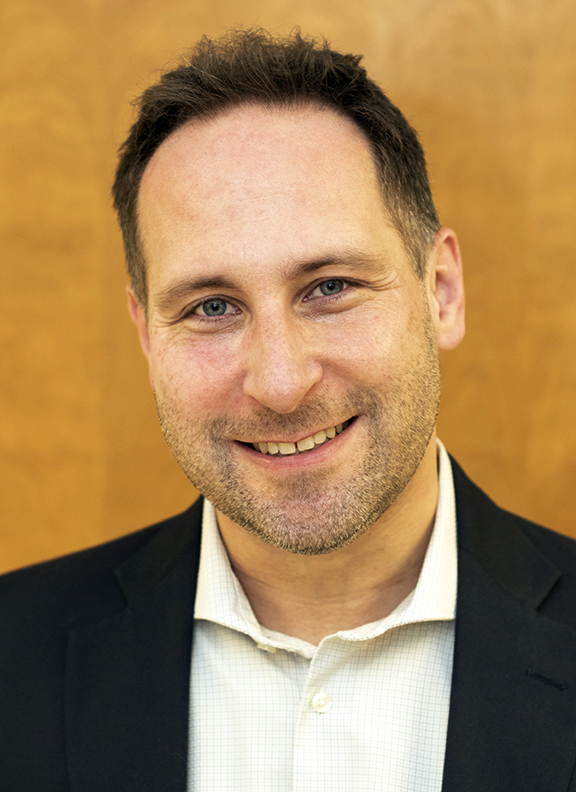 Robert Welner, Ph.D., assistant professor in the Division of Hematology and Oncology, is the latest winner of the School of Medicine’s Featured Discovery. This initiative celebrates important research from the School of Medicine faculty members.
Robert Welner, Ph.D., assistant professor in the Division of Hematology and Oncology, is the latest winner of the School of Medicine’s Featured Discovery. This initiative celebrates important research from the School of Medicine faculty members.
Working with first author and trainee, Anaïs Wanet, Welner and co-mentor Daniel Tenen, M.D., head of the Blood Program at Harvard Stem Cell Institute, were published in Science Immunology for their paper “E-cadherin is regulated by GATA-2 and marks the early commitment of mouse hematopoietic progenitors to the basophil and mast cell fates.”
Welner explains that blood stem and progenitor cells are a complex, mixed population within the bone marrow. More specifically, myeloid progenitors are upstream of several white cells that immediately respond to infections–macrophages, neutrophils, basophils, mast cells, and monocytes.
Welner says blood progenitors mature into their own, unique cell types. However, patterns responsible for making each of these cell types had not previously been isolated. “Our publication identifies some of the unique patterns,” Welner says.
They looked at differentiation of myeloid progenitors primed for making basophil and mast cells.
Welner’s team used RNA sequencing to observe transcriptional priming of myeloid progenitors to make basophil and mast cell lineages. They showed that GATA-2 directly regulates E-cadherin expression in the basophil and mast cell lineages—which provides a mechanistic connection between the expression of this cell surface marker to the basophil and mast cell fate specification.
“We were so happy to have Anaïs Wanet’s paper featured on the cover of Science Immunology. Co-mentoring Anaïs on this project with Dr. Daniel Tenen paved the way for this significant finding,” Welner says.
Studying E-cadherin expressing progenitor cells in leukemia patient samples may help future researchers define the subtype of disease. This discovery provides insight into the transcriptional landscape of the blood cells and might indicate a personalized course of treatment in leukemia—a huge breakthrough in scientific understanding of blood cell development and leukemia.
The School of Medicine communications staff sat down with Dr. Welner to gain insights about the research of this study, UAB, and the science community.
Q: What compelled you to pursue this research?
I think this project is a good representation of the reality of basic science and the much-needed perseverance. Our original observation was that E-cadherin was expressed in many acute myeloid leukemias. We thought that this surface marker would serve as a functional component of the disease. But we were very wrong! We acquired E-cadherin knockout mice, and then put in several leukemic oncogenes, but with no observable impact on the disease. When Anaïs thought more about these observations, she was able to uniquely show that the transcription factor GATA2 regulates E‑cadherin expression in the basophil and mast cell lineages as well as in myeloid leukemias. In doing so, she provided the mechanistic connection between the presentation of this cell surface marker and the basophil and mast cell fate specification.
Q: What was your most unexpected finding?
There have been significant advancements in ‘omics-based approaches to science; we can sequence DNA and RNA quickly and for less costs. By combining single-cell RNA sequencing analyses and immunophenotyping, we revealed that granulocyte-monocyte progenitors (GMPs) expressing high levels of E‑cadherin have an enriched capacity to differentiate into basophils and mast cells. Using RNA‑sequencing, we also observed the transcriptional priming of these myeloid progenitors to the basophil and mast cell lineages. This gave us insight into the transcription factors mediating E-cadherin expression. Moving from an extensive ‘omics-based approach to validating these findings using cell sorting and single-cell differentiation assays shows the power and ability of these methodologies to move science forward.
Q: How do you feel your research will impact the science community?
Importantly, we report that most basophil and mast cell progenitors can be identified and FACS-sorted based on the expression of a relatively specific marker, E-cadherin, circumventing the need for reporter strains. Although we investigated E-cadherin as a marker in this study, several ligands for E‑cadherin have been described. These ligands are expressed by multiple immune and non-immune cell subsets, suggesting that E‑cadherin expression on basophils and mast cells might be necessary for their ability to interact with numerous other cell types. Future studies will identify the cell-cell interactions mediated by E‑cadherin to understand how it may modulate basophil and mast cell progenitors during health and disease.
Q: What is your research’s relevance to human disease?
Studying E-cadherin expressing progenitor cells in leukemia patient samples could help control define the subtype of disease. This surface marker provides insight into the transcriptional landscape of the leukemic cells and might indicate a personalized course of treatment. We expect this will be one of many surface markers found that show the intracellular signaling pathways of cells within a heterogeneous population. Knowing the critical subpopulations of leukemic cells and those of minor clones in myeloid malignancies will be vital determinants for tailoring specific therapy to prevent relapse.
Q: What do you find makes the science community here unique?
There are experts scattered all over the UAB campus in different departments, divisions, and cores. The only limitation for success is not leaving your office or laboratory to have conversations with your peers. Our small group has established several collaborations, receiving help and giving our knowledge and skillsets to others on campus. UAB’s scientific environment is outstanding, and we are thankful to be a small part of this very large community.